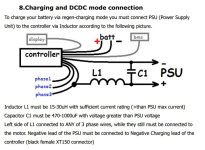Farfle
100 kW
Heya all, Under the advice and guidance from some very bright folks, I am starting a charger project. This will mostly be for E-motorcycle and car sized things, but the topology should work for anything.
First off, this is a "big boy rules" charger that is for those who know what they are getting into. Mainly because it is not line isolated, so any love from a grounded outlet plate while touching a non-battery isolated EV will be a painful (but most likely non-fatal) experience.
First off, how this charger differs from "normal" chargers:
Most normal chargers are laid out with a flyback based boosting PFC input stage that feeds into a bucking output stage thru a transformer. They take power from the wall very cleanly, and deliver clean, isolated and ripple free power to the battery.
Here is the layout of the important (heat and cost) producing parts in a "normal" charger:
Rectification stage -> Input caps-> Boosting flyback transistor -> flyback transformer -> Bucking output transistor -> Bucking output inductor -> Output caps.
The problem with this existing design, is that the flyback based PFC stage gets large and expensive to create high currents with, and you still need a second stage to buck the voltage back down to battery level.
Another problem with existing designs, is their obsession with creating smooth output power, this costs money, complexity and power density. It is my understanding that lithium cells are not affected by even large ripple currents (and a resident battery expert has even stated that some ripple current is actually better)
That all being said, this is the configuration of the "heat and cost" parts in the charger I want to build:
Rectification stage->Bucking output transistor -> Bucking output inductor
As you can see, this charger does away with a large amount of the "normal charger" parts, and It suffers some penalties because of it, including:
1. Poor PFC at higher relative output to input voltages
2. Cannot charge a battery that is higher voltage than the rectified AC wave peak voltage.
3. No output isolation from mains input voltage.
The advantages of this design, is that there is only a rectifier, a single mosfet, one diode, and one Inductor in the current path. voltage is kept low, and that lets this take advantage of some super baller new-to-market mosfets from STMicro and CREE. These SiC based fets are ~300-700V and have very low RDSon, and very low gate capacitance. Cree's dev inverter kit is switching 50kw at 200khz, and uses an inductor the size of a fist, instead of the 10khz IGBT solution which used an inductor the size of a large melon.
Anywho, that was a large block of text. The next post will get a bit more in depth on the buck stage, and the control uController.
First off, this is a "big boy rules" charger that is for those who know what they are getting into. Mainly because it is not line isolated, so any love from a grounded outlet plate while touching a non-battery isolated EV will be a painful (but most likely non-fatal) experience.
First off, how this charger differs from "normal" chargers:
Most normal chargers are laid out with a flyback based boosting PFC input stage that feeds into a bucking output stage thru a transformer. They take power from the wall very cleanly, and deliver clean, isolated and ripple free power to the battery.
Here is the layout of the important (heat and cost) producing parts in a "normal" charger:
Rectification stage -> Input caps-> Boosting flyback transistor -> flyback transformer -> Bucking output transistor -> Bucking output inductor -> Output caps.
The problem with this existing design, is that the flyback based PFC stage gets large and expensive to create high currents with, and you still need a second stage to buck the voltage back down to battery level.
Another problem with existing designs, is their obsession with creating smooth output power, this costs money, complexity and power density. It is my understanding that lithium cells are not affected by even large ripple currents (and a resident battery expert has even stated that some ripple current is actually better)
That all being said, this is the configuration of the "heat and cost" parts in the charger I want to build:
Rectification stage->Bucking output transistor -> Bucking output inductor
As you can see, this charger does away with a large amount of the "normal charger" parts, and It suffers some penalties because of it, including:
1. Poor PFC at higher relative output to input voltages
2. Cannot charge a battery that is higher voltage than the rectified AC wave peak voltage.
3. No output isolation from mains input voltage.
The advantages of this design, is that there is only a rectifier, a single mosfet, one diode, and one Inductor in the current path. voltage is kept low, and that lets this take advantage of some super baller new-to-market mosfets from STMicro and CREE. These SiC based fets are ~300-700V and have very low RDSon, and very low gate capacitance. Cree's dev inverter kit is switching 50kw at 200khz, and uses an inductor the size of a fist, instead of the 10khz IGBT solution which used an inductor the size of a large melon.
Anywho, that was a large block of text. The next post will get a bit more in depth on the buck stage, and the control uController.



